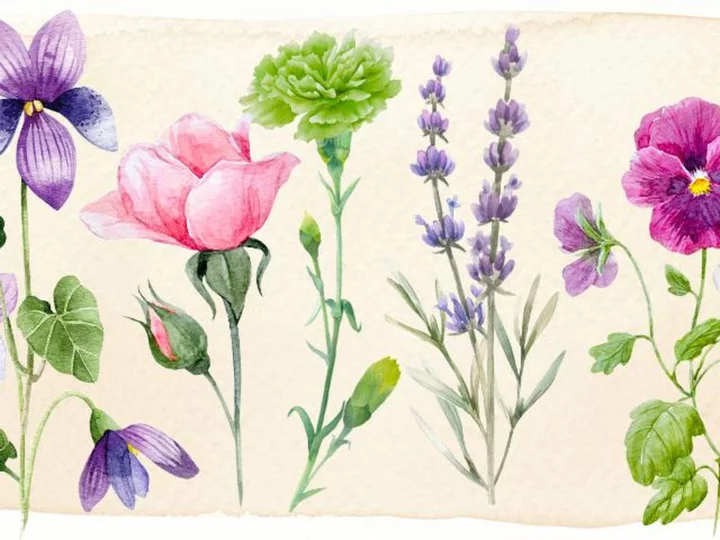Flowers have their own vast language, communicating love, disdain and everything in between. Throughout history, LGBTQ communities have also used the subtle language of flowers to broadcast solidarity or personal identity, all through something as simple as a bloom pinned to a lapel. Many of these flowers have deep connections to queer icons or are echoed in other queer symbols.
While flowers have always carried some symbolism through different eras and cultures, the language of flowers became a popular pastime during the Victorian era when social communication was heavily coded -- especially when it came to romance. (Even more complex emotions like, say, bashfulness, were associated with their own flowers, which surely wasn't confusing at all.)
It makes sense, then, that queer communities would find both beauty and belonging by continuing this interesting tradition.
Lavender
Purple hues have been associated with LGBTQ communities since the time of Sappho (more on her later), but lavender fully entered the gay lexicon at the end of the 19th century. Why this particular hue? Some suppose it's because it's a mix of pink and blue. Other historians point to the color being linked to effeminacy. Lavender was a fashionable color in Europe at the time and eventually became synonymous with an appreciation for art and beauty which, at the time, was seen as unmanly in certain circles.
The color lavender saw another boost in queer visibility when it was donned by participants in a "gay power" march in New York City in 1969, a month after the pivotal Stonewall Riots. That same year, Betty Friedan, the leader of the National Organization for Women, criticized lesbian membership, which she thought would be a threat to feminism. She called this imagined threat the "lavender menace" -- a colorful (in more than one way) term that lesbian activists immediately adopted as their own.
The term "lavender" often acted as a discreet way of describing something gay. Lavender marriages, for instance, were noted among celebrities through the mid-20th century. In these unions, either one or both members of a couple were gay, and the marriage was an intentional ruse to ward off public questions about sexuality.
Today, the lavender flower still appears in newer symbols of queerness. The "cottagecore" aesthetic, one of simple, quiet living in nature, has many intersections with queer and hyper-feminine aesthetics, like frogs, mushrooms and, yes, botanicals. Even a lavender latte -- best made with oat milk -- has become a sly modern symbol of "gay culture."
Violet
Violets are intertwined with the lore of Sappho, the famous poet from Greek antiquity. From her, we get the words "sapphic" and "lesbian," in reference to her home on the Isle of Lesbos. In one of her poems, which are laden with erotic references to women, she writes:
"You put on many wreaths of violets and roses ... together by my side, and round your tender neck you put many woven garlands made from flowers."
Her lush symbolism of violets and other purple flowers has persisted through the years, with depictions of Sappho often showing the poet adorned with purple blooms.
Like lavender, violets emerged again as a symbol of queerness at the turn of the 20th century, thanks to groups of women in Paris who oversaw a resurgence of interest in Sappho's work. Among these "Paris Lesbos" was a British poet named Renée Vivien, who relied heavily on the symbolism of violets in her work and her personal aesthetic, both as a tribute to Sappho and one of her lovers.
In 1926, a play by Edouard Bourdet made the link even more public. The story of "The Captive" features a woman, engaged to a man, who is secretly in a relationship with another woman. In the play, her lover gives her several gifts of violets. The connection made the flower unfashionable among some circles, but gay men and women and their allies attended the play and pinned violets to their outfits in a show of support.
Pansy
"Pansy" is widely known as a pejorative term for a gay man, implying weakness and effeminacy. (In reality, pansy flowers are quite hardy!) However, at the turn of the 20th century it was just one of several similar botanical epithets, including "daisy," "buttercup," and the vague, yet prestigious-sounding "horticultural lad."
In the 1930s, the "Pansy Craze" described a rising lifestyle of queer bohemianism, characterized by parties featuring drag artists, or "pansy performers," as well as an air of unapologetic flamboyance. This movement is considered to be the beginning of gay nightlife culture. The term is also a good illustration of how marginalized communities sometimes retake words used against them. The Pansy Project, a movement started by LGBTQ activist Paul Harfleet, plants pansies at the site of homophobic and transphobic abuse.
Rose
The rose is the ultimate floral symbol of love, and that includes queer love. The rose was the flower of Eros, the Greco-Roman god of passion and erotic love.
In Japanese history, the rose has been associated with gay men. The Japanese word for rose is pronounced "bara," and experienced a resurgence in queer media in the 1960s and 1970s. Japan's first commercially produced gay magazine, first printed in 1971, was called "Barazoku," or "rose tribe." Roses, especially in multiple colors or "tie dyed" with rainbow hues, are a popular flower used at Pride events.
Green carnation
A green carnation seems an odd flower to choose for a symbol, but the man who popularized it was considered rather odd himself. Irish writer Oscar Wilde, who was well-known for his romantic interests in men, used green carnations to create a stir around the 1892 opening of his play, "Lady Windermere's Fan." Wilde asked the actors and some of his admirers to wear the flowers, but did not give a reason why. History suggests he lifted this trend from Paris, where green carnations were rumored to be a sign of affiliation among gay men.

